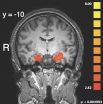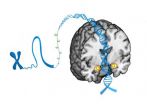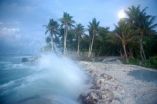(Press-News.org) Neurons are the cells of our brain, spinal cord, and overall nervous system. They form complex networks to communicate with each other through electrical signals that are carried by chemicals. These chemicals bind to structures on the surface of neurons that are called neuroreceptors, opening or closing electrical pathways that allow transmission of the signal from neuron to neuron. One neuroreceptor, called 5HT3-R, is involved in conditions like chemotherapy-induced nausea, anxiety, and various neurological disorders such as schizophrenia. Despite its clinical importance, the exact way that 5HT3-R works has been elusive because its complexity has prevented scientists from determining its three-dimensional structure. Publishing in Nature, EPFL researchers have now uncovered for the first time the 3D structure of 5HT3-R, opening the way to understanding other neuroreceptors as well.
Neuroreceptors: structure and function
Communication between the neurons of our body is mediated by neuroreceptors that are embedded across the cell membrane of each neuron. Neuronal communication begins when a neuron releases a small molecule, called a 'neurotransmitter', onto a neighboring neuron, where it is identified by its specific neuroreceptor and binds to it. The neurotransmitter causes the neuroreceptor to open an electrically conducting channel, which allows the passage of electrical charge across the neuron's membrane. The membrane then becomes electrically conducting for a fraction of a millisecond, generating an electrical pulse that travels across the neuron. The family of neuroreceptors that work in this way is widespread across the nervous system, and is referred to as the "ligand-gated channel" family.
The mystery is how the binding of the neurotransmitter can induce the opening of an electrical channel to transport a signal into the neuron. The understanding of these molecular machines is of great medical importance, especially since neuroreceptors are involved in many neurological diseases. Currently, none of the mammalian ligand-gated channel neuroreceptors have been structurally described, which significantly limits our understanding of their function on a molecular level.
Uncovering the structure of 5HT3-R
The team of Horst Vogel at EPFL has used X-ray crystallography to determine the 3D structure of a representative ligand-gated channel neuroreceptor, the type-3 serotonin receptor (5HT3-R). This neuroreceptor recognizes the neurotransmitter serotonin and opens a transmembrane channel that allows electrical signals to enter certain neurons. The 5HT3 receptor was grown in and then isolated from human cell cultures, and finally crystallized.
But before obtaining the 5HT3-R crystals, the EPFL team had to overcome a number of challenges. First, the relatively large size of the membrane-embedded 5HT3-R, like that of other similar channel neuroreceptors, makes it notoriously difficult to purify in sufficient quality and quantity. After years of painstaking work, the EPFL scientists succeeded in obtaining a few milligrams of 5HT3-R, which was still not enough to grow crystals using conventional methods.
Still, the crystal quality was insufficient. To address this, Vogel's team used small antibodies, so-called nanobodies, which were obtained from llamas after the animals were injected with purified 5HT3-R. From a large library of isolated nanobodies, a particular one was found to form a stable complex with the 5HT3-R, and this complex eventually yielded crystals of exceptional quality.
After this, the procedure was straightforward: The crystals for X-ray crystallography were investigated at the synchrotron facilities at the Paul Scherrer Institut in Villigen and the European facilities in Grenoble. In this well-established technique, the crystals diffract X-rays in a characteristic pattern from which the 3D structure can be reconstructed.
The X-ray diffraction experiments yielded the 3D structure of 5HT3-R at an unprecedented resolution of 3.5 Ångstroms (3.5 millionths of a millimeter). The resulting 3D image shows a bullet-shaped 5HT3 receptor with its five subunits symmetrically arranged around a central water-filled channel that traverses the neuron's cell membrane. The channel can adopt two states: a closed, electrically non-conducting state or, after binding a neurotransmitter, an open, electrically conducting state that allows the flow of electrical charges in and out of the neuron to generate an electrical signal.
"We have now elucidated the molecular anatomy of a receptor that plays a central role in neuronal transmission," says Horst Vogel. "It is the first 3D structure of its kind and may serve as a blueprint for the other receptors of this family. In the next step, we have to improve the resolution of the structure, which might give us information on how to design novel medicines that influence this neuroreceptor's function."
INFORMATION:
This work represents a collaboration between EPFL's Laboratory of Physical Chemistry of Polymers and Membranes; the Center for Cellular Imaging and NanoAnalytics of the University of Basel; the Swiss Light Source and the Laboratory of Biomolecular Research of the Paul Scherrer Institute; the Architecture et Fonction des Macromolécules Biologiques of the Centre National de la Recherche Scientifique; the Université Grenoble Alpes; and the Unité de Dynamique Structurale des Macromolécules of the Institut Pasteur.
Reference
Hassaine G, Deluz C, Grasso L, Wyss R, Tol MB, Hovius R, Graff A, Stahlberg H, Tomizaki T, Desmyter A, Moreau C, Li X-D, Poitevin F, Vogel H, Nury H. X-ray structure of the mouse serotonin 5-HT3 receptor. Nature DOI: 10.1038/nature13552
Uncovering the 3-D structure of a key neuroreceptor
2014-08-03
ELSE PRESS RELEASES FROM THIS DATE:
Fault trumps gruesome evidence when it comes to punishment
2014-08-03
Issues of crime and punishment, vengeance and justice date back to the dawn of human history, but it is only in the last few years that scientists have begun exploring the basic nature of the complex neural processes in the brain that underlie these fundamental behaviors.
Now a new brain imaging study – published online Aug. 3 by the journal Nature Neuroscience – has identified the brain mechanisms that underlie our judgment of how severely a person who has harmed another should be punished. Specifically, the study determined how the area of the brain that determines ...
Small DNA modifications predict brain's threat response
2014-08-03
DURHAM, N.C. -- The tiny addition of a chemical mark atop a gene that is well known for its involvement in clinical depression and posttraumatic stress disorder can affect the way a person's brain responds to threats, according to a new study by Duke University researchers.
The results, which appear online August 3 in Nature Neuroscience, go beyond genetics to help explain why some individuals may be more vulnerable than others to stress and stress-related psychiatric disorders.
The study focused on the serotonin transporter, a molecule that regulates the amount of ...
Knowing what to keep and what to trash: How an enzyme distinguishes cellular messages
2014-08-03
Cold Spring Harbor, NY – Every once in a while, we are forced to sort that stack of papers on the kitchen counter. Interspersed between the expired coupons and dozens of takeout menus are important documents like your car insurance or electric bill. So it isn't an option to simply drop it all in the trash at once – you need to read through the messages to be sure that you don't lose vital information.
In the cell, proteins similarly read through messages to distinguish what needs to be saved and what needs to be discarded. But, here, the process takes on a much more ...
Atlantic origin of recent Pacific trade wind, sea level and temperature trends
2014-08-03
An Australian–US team of climate researchers has solved a puzzle that has challenged scientists for over a decade. Climate models predict that the equatorial Pacific trades should weaken with increasing greenhouse gases. Yet, since the early 1990s, satellites and climate stations reveal a rapid and unprecedented strengthening of the Pacific trade winds, accelerating sea level rise in the western Pacific and impacting both Pacific and global climate.
"The answer to the puzzle is that recent rapid Atlantic Ocean warming has affected climate in the Pacific," say the scientists. ...
Self-assembling anti-cancer molecules created in minutes
2014-08-03
Researchers have developed a simple and versatile method for making artificial anti-cancer molecules that mimic the properties of one of the body's natural defence systems.
The chemists, led by Professor Peter Scott at the University of Warwick, UK, have been able to produce molecules that have a similar structure to peptides which are naturally produced in the body to fight cancer and infection.
Published in Nature Chemistry, the molecules produced in the research have proved effective against colon cancer cells in laboratory tests, in collaboration with Roger Phillips ...
Study finds new genetic risk markers in pancreatic cancer
2014-08-03
BOSTON –– A large DNA analysis of people with and without pancreatic cancer has identified several new genetic markers that signal increased risk of developing the highly lethal disease, report scientists from Dana-Farber Cancer Institute.
The markers are variations in the inherited DNA code at particular locations along chromosomes. Several of these variations in the DNA code were identified that influence an individual's risk for pancreatic cancer.
The discovery of these markers – along with four that were previously identified is important for several reasons, said ...
Rare developmental disorder linked to tumor-suppressing protein, Stanford researchers find
2014-08-03
CHARGE, which affects 1 in 10,000 babies, is an acronym whose letters stand for some of the more common symptoms of the condition: coloboma of the eye, heart defects, atresia of the choanae, retardation of growth and/or development, genital and/or urinary abnormalities, and ear abnormalities and deafness.
Originally, the researchers were examining the tumor-suppressive properties of the protein, called p53, not investigating developmental disorders. But when a mouse model developed a strange set of deficiencies, the researchers followed a trail of clues that led them ...
UMD researchers develop tool to better visualize, analyze human genomic data
2014-08-03
Scientists at the University of Maryland have developed a new, web-based tool that enables researchers to quickly and easily visualize and compare large amounts of genomic information resulting from high-throughput sequencing experiments. The free tool, called Epiviz, was described in a paper published online on August 3, 2014 in the journal Nature Methods.
Next-generation sequencing has revolutionized functional genomics. These techniques are key to understanding the molecular mechanisms underlying cell function in healthy and diseased individuals and the development ...
Making sense of scents
2014-08-03
For many animals, making sense of the clutter of sensory stimuli is often a matter or literal life or death.
Exactly how animals separate objects of interest, such as food sources or the scent of predators, from background information, however, remains largely unknown. Even the extent to which animals can make such distinctions, and how differences between scents might affect the process were largely a mystery – until now.
A new study, described in an August 3 paper in Nature Neuroscience, a team of researchers led by Venkatesh Murthy, Professor of Molecular and Cellular ...
Clues to curbing obesity found in neuronal 'sweet spot'
2014-08-02
New Haven, Conn. -- Preventing weight gain, obesity, and ultimately diabetes could be as simple as keeping a nuclear receptor from being activated in a small part of the brain, according to a new study by Yale School of Medicine researchers.
Published in the Aug. 1 issue of The Journal of Clinical Investigation (JCI), the study showed that when the researchers blocked the effects of the nuclear receptor PPARgamma in a small number of brain cells in mice, the animals ate less and became resistant to a high-fat diet.
“These animals ate fat and sugar, and did not gain ...







